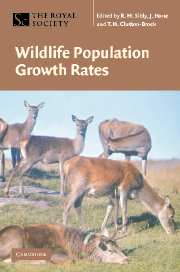Book contents
- Frontmatter
- Contents
- List of contributors
- 1 Introduction to wildlife population growth rates
- 2 Population growth rate and its determinants: an overview
- 3 Demographic, mechanistic and density-dependent determinants of population growth rate: a case study in an avian predator
- 4 Estimating density dependence in time-series of age-structured populations
- 5 Pattern of variation in avian population growth rates
- 6 Determinants of human population growth
- 7 Two complementary paradigms for analysing population dynamics
- 8 Complex numerical responses to top-down and bottom-up processes in vertebrate populations
- 9 The numerical response: rate of increase and food limitation in herbivores and predators
- 10 Populations in variable environments: the effect of variability in a species' primary resource
- 11 Trophic interactions and population growth rates: describing patterns and identifying mechanisms
- 12 Behavioural models of population growth rates: implications for conservation and prediction
- 13 Comparative ungulate dynamics: the devil is in the detail
- 14 Population growth rate as a basis for ecological risk assessment of toxic chemicals
- 15 Population growth rates: issues and an application
- References
- Glossary of abbreviations
- Author index
- Subject index
1 - Introduction to wildlife population growth rates
Published online by Cambridge University Press: 20 May 2010
- Frontmatter
- Contents
- List of contributors
- 1 Introduction to wildlife population growth rates
- 2 Population growth rate and its determinants: an overview
- 3 Demographic, mechanistic and density-dependent determinants of population growth rate: a case study in an avian predator
- 4 Estimating density dependence in time-series of age-structured populations
- 5 Pattern of variation in avian population growth rates
- 6 Determinants of human population growth
- 7 Two complementary paradigms for analysing population dynamics
- 8 Complex numerical responses to top-down and bottom-up processes in vertebrate populations
- 9 The numerical response: rate of increase and food limitation in herbivores and predators
- 10 Populations in variable environments: the effect of variability in a species' primary resource
- 11 Trophic interactions and population growth rates: describing patterns and identifying mechanisms
- 12 Behavioural models of population growth rates: implications for conservation and prediction
- 13 Comparative ungulate dynamics: the devil is in the detail
- 14 Population growth rate as a basis for ecological risk assessment of toxic chemicals
- 15 Population growth rates: issues and an application
- References
- Glossary of abbreviations
- Author index
- Subject index
Summary
This book takes a fresh approach to some of the classic questions in ecology. In particular, what determines where a species lives and what determines its abundance? Despite great progress in the twentieth century much more remains to be done before we can provide full answers to these questions so that reliable predictions can be made as to what will be found in unstudied areas or times. We believe that the methods described and deployed in this book point the way forward. The core message of the book is that key insights come from understanding what determines population growth rate (pgr). We believe that application of this approach will make ecology a more predictive science.
In this chapter we begin with an introduction to the major themes of the book, and then after briefly indicating how population growth rate is defined, we describe the contents of the book in more detail. Those who require more background material will find a brief guide to available texts at the end.
Major themes
In briefest outline, the approach taken in this book is as follows. Questions as to what determines where species live are questions about what values of environmental factors allow populations to persist. Populations persist where pgr ≥ o, so the environmental conditions that produce pgr ≥ o are the conditions in which the species can live. This line of reasoning suggests that to understand what determines where species live, we should study the relationships between environmental factors and pgr.
- Type
- Chapter
- Information
- Wildlife Population Growth Rates , pp. 1 - 10Publisher: Cambridge University PressPrint publication year: 2003
- 2
- Cited by

